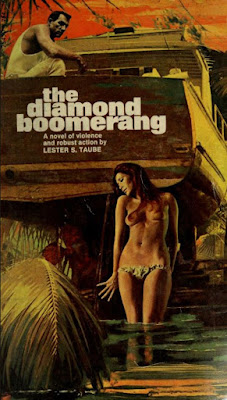Rex Brandon is a geologist and big game hunter by trade, but a swashbuckling adventurer at heart. Death Warriors finds Rex summoned to the heart of savage Africa by a French colonialist in the fictional African nation of Mandibarza. Brandon’s mission is to locate an explorer who went missing in the jungle while he was searching for irikum, a rare mineral valued for its potential to produce atomic energy.
Using the guise of a big game hunt with a goal of shooting gorillas (which, I guess, was a thing in 1951?), Rex and his small expeditionary team set off into the jungle to locate the missing explorer and the irikum. The reader also learns that another search party with the identical mission previously became lost and never returned from the wilds. The previous mission included a beautiful woman named Coralie, and you’d correctly surmise that she will be the damsel in distress requiring saving at some point.
In the jungle, it quickly becomes clear that there are others in the woods - beyond the man-eating lions - who wish to thwart the expedition. Members of the party start disappearing, and supplies are scarce. There’s not a ton of action in the novel’s first half, but the Blair Witch Project vibe of the thick and menacing woods is certainly unsettling. Things go from bad to worse for Rex and his companions when the war-painted, jungle savages (of the “ooga-booga” variety) make their inevitable appearance halfway through the adventure.
If the novel’s first half is mostly setup (although not uninteresting), the second half moves quickly from one pulpy action set-piece to another. Rex and his sidekicks are forced to tangle with every flavor of African jungle menace you can imagine, and it’s a cartoonish blast building up to a conclusion that leaves Rex alive to experience the next 11 adventures in the series.
Fans of Tarzan and Doc Savage will feel right at home with Rex Brandon. Based on this short novel, it seems that pulp-fiction from Great Britain in 1951 has a lot in common with American pulp-fiction from the 1930s. While Americans were turning a page to the gritty realism of 1950s noir, British readers were still enjoying square-jawed heroes rescuing women from the jaws of killer crocodiles in the darkest realms of Africa. Whichever your preference, we should all be grateful that there are outfits like Bold Venture Press keeping these works of pulp literature alive in the 21st Century.
Buy a copy of the book HERE




















